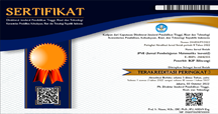HEURISTIK SISWA PEREMPUAN SMP DALAM MEMECAHKAN MASALAH POLA BILANGAN
DOI:
https://doi.org/10.22460/jpmi.v5i3.10699Keywords:
Heuristic, number patterns, female studentsAbstract
This study aims to describe the heuristics of female junior high school students in solving number pattern problems. Two subjects were selected through the provision of a mathematical ability test (TKM) and a problem-solving test (TPM 1) in class VIII E of SMP AL-Hikmah 2 Benda. The instrument used for problem solving test (TPM 1 & 2), and interview guide. The data analysis technique uses data reduction, data presentation, and drawing conclusions. The results showed that female students used heuristics to make systematic lists, guess & check, and use models in solving number pattern problems. In addition, female students use their visual representation skills by making guide lines that are used to find the nth pattern and help use their intuition by counting manually until a developed pattern is found. Female students also use the ability to generalize to get the formula for the nth pattern and use knowledge about the types of number patterns to be able to guess the formula for the nth pattern.Â
References
Andrade, R. R., Fortes, E. C., & Mabilangan, R. A. (2020). Problem solving heuristics and mathematical abilities of heterogeneous learners. Universal Journal of Educational Research, 8(11), 5114–5126. https://doi.org/10.13189/ujer.2020.081111
Capraro, M. M., An, S. A., Ma, T., Rangel-Chavez, A. F., & Harbaugh, A. (2012). An investigation of preservice teachers’ use of guess and check in solving a semi open-ended mathematics problem. Journal of Mathematical Behavior, 31(1), 105–116. https://doi.org/10.1016/j.jmathb.2011.10.002
Chan, Z. S., & Abu Bakar, M. A. (2021). Does Gender Difference Play a Significant Role in Verbal and Visuospatial Working Memory Performance? Journal of Cognitive Sciences and Human Development, 7(2), 80–90. https://doi.org/10.33736/jcshd.3744.2021
Dale, S. (2015). Heuristics and biases: The science of decision-making. Business Information Review, 32(2), 93–99. https://doi.org/10.1177/0266382115592536
Fadiana, M., Amin, S. M., & Lukito, A. (2017). Generalization of Visual Pattern. IOSR Journal of Research & Method in Education (IOSR-JRME), 7(6), 29–32. https://doi.org/10.9790/7388-0706032932
Fan, L., & Zhu, Y. (2007). Representation of problem-solving procedures: A comparative look at China, Singapore, and US mathematics textbooks. Educational Studies in Mathematics, 66(1), 61–75. https://doi.org/10.1007/s10649-006-9069-6
Hensberry, K. K. R., & Jacobbe, T. (2012). The effects of Polya’s heuristic and diary writing on children’s problem solving. Mathematics Education Research Journal, 24(1), 59–85. https://doi.org/10.1007/s13394-012-0034-7
Prayekti, N., Nusantara, T., Sudirman, & Susanto, H. (2020). Eighth-grades students’ mental models in solving a number pattern problem. Journal for the Education of Gifted Young Scientists, 8(3), 973–989. https://doi.org/10.17478/JEGYS.708044
Rott, B., Specht, B., & Knipping, C. (2021). A descriptive phase model of problem-solving processes. ZDM - Mathematics Education, 53(4), 737–752. https://doi.org/10.1007/s11858-021-01244-3
Sari, N. P. N., Fuad, Y., & Ekawati, R. (2020). Profil Berpikir Aljabar Siswa SMP Dalam Menyelesaikan Masalah Pola Bilangan. Kreano, Jurnal Matematika Kreatif-Inovatif, 11(1), 56–63. https://doi.org/10.15294/kreano.v11i1.22525
Sarouphim, K. M., & Chartouny, M. (2017). Mathematics education in Lebanon: gender differences in attitudes and achievement. Educational Studies in Mathematics, 94(1), 55–68. https://doi.org/10.1007/s10649-016-9712-9
Sewasew, D., Schroeders, U., Schiefer, I. M., Weirich, S., & Artelt, C. (2018). Development of sex differences in math achievement, self-concept, and interest from grade 5 to 7. Contemporary Educational Psychology, 54, 55–65. https://doi.org/10.1016/j.cedpsych.2018.05.003
Son, J. W., & Lee, M. Y. (2021). Exploring the Relationship Between Preservice Teachers’ Conceptions of Problem Solving and Their Problem-Solving Performances. International Journal of Science and Mathematics Education, 19(1), 129–150. https://doi.org/10.1007/s10763-019-10045-w
Thien, L. M. (2016). Malaysian Students’ Performance in Mathematics Literacy in PISA from Gender and Socioeconomic Status Perspectives. Asia-Pacific Education Researcher, 25(4), 657–666. https://doi.org/10.1007/s40299-016-0295-0
Verschaffel, L., Schukajlow, S., Star, J., & Van Dooren, W. (2020). Word problems in mathematics education: a survey. ZDM - Mathematics Education, 52(1), 1–16. https://doi.org/10.1007/s11858-020-01130-4
Yazgan, Y. (2016). Fourth Graders and Non-Routine Problems: Are Strategies Decisive for Success? European Journal of Education Studies, 2(4), 100–120.

















